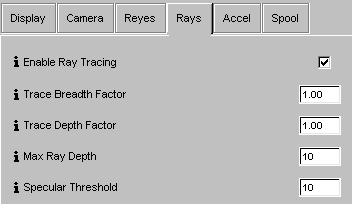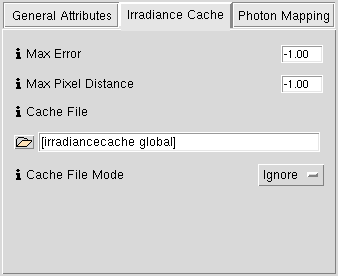The Rays Panel
 Enable Ray Tracing - Global control for enabling and disabling ray
tracing. This causes MTOR to tag each object with visibility attributes
required by PRMan's ray tracing subsystem. Only objects made visible to
this subsystem will appear in ray traced reflections and shadows.
Enable Ray Tracing - Global control for enabling and disabling ray
tracing. This causes MTOR to tag each object with visibility attributes
required by PRMan's ray tracing subsystem. Only objects made visible to
this subsystem will appear in ray traced reflections and shadows.
Trace Breadth Sample Factor - A global multiplier for all
multi-sampling ray tracing operations. Setting this to a value greater that 1
will increase sampling quality and slow down the rendering. Set this to a
value less than 1 to speed up your renderings. Currently, this setting
will only affect ray tracing shaders that are "trace sample factor
savvy." This includes all factory slim shaders.
Trace Depth Sample Factor - A global multiplier for all multi-sampling ray tracing operations that
varies the requested ray sample count according to the current ray
depth. During preview rendering, a value less than 1 should be used.
Smaller values result in a coarser approximation but yield significant
speed improvements, and the gritty artifacts aren't entirely unpleasant.
Currently, this setting will only affect ray tracing shaders that are
"trace sample factor savvy." This includes all factory slim shaders.
Max Ray Depth - This sets a limit to the number of bounces any ray can travel regardless of its type.
Specular Threshold - This angle controls the categorization of a ray path. Rays scattered in regions smaller than this value are specular. Larger regions yield diffuse ray paths.
|
 This panel controls aspects related to irradiance caching. The irradiance cache can be used to accelerate global illumination calculations and can be stored in irradiance cache files for future reuse. You can have any number of independent irradiance cache contexts to override the scene-wide default established here. This panel controls aspects related to irradiance caching. The irradiance cache can be used to accelerate global illumination calculations and can be stored in irradiance cache files for future reuse. You can have any number of independent irradiance cache contexts to override the scene-wide default established here.
Max Error - An error metric to control quality/speed tradeoff for indirect illumination.
Larger numbers result in a coarser approximation but speed up the rendering.
Set this value to 0 if you wish to force a recalculation of global illumination
at every point. Set this value to a million to force complete reliance on
indirect seed file, if provided. This value acts as the default and you can
override this value on a per-primitive basis via the Slim Ensemble.
Max Pixel Distance - A secondary error metric to control quality/speed tradeoff for indirect illumination.
Larger numbers result in a coarser approximation but speed up the rendering.
Set this value to 0 if you wish to force a recalculation of global illumination
at every point. Set this value to a million to force complete reliance on
indirect seed file, if provided. This value acts as the default and you can
override this value on a per-primitive basis via the Slim Ensemble.
Cache File - An irradiance cache file is used to accelerate the indirect diffuse
calculations. During image generation, the renderer continuously
updates the various internal irradiance caches and these results
can be reused - either to speed up test renders, or to "bake"
the irradiance calculations once and for all for a final model
or scenario. As your set and lighting design begins to settle
out, you can save lots of rendering time by setting the file mode
to Read and using a cached file. Refer to the help for Irradiance
File Mode for more.
Cache File Mode - The file mode associated with the Irradiance
Cache, which controls how a cache file is used. When set to Ignore, the
cache files are read and no cache is saved to disk. When set to Read,
cached data will be referenced. When set to Write, any existing cache file will be ignored, effectively starting with a blank slate. The state of the cache
will be written to the file when rendering completes.
|
 Rays
- Irradiance Cache
Rays
- Irradiance Cache Rays
- Irradiance Cache
Rays
- Irradiance Cache